Friends of the Earth Scotland’s members’ magazine Issue 94 I Winter 2024
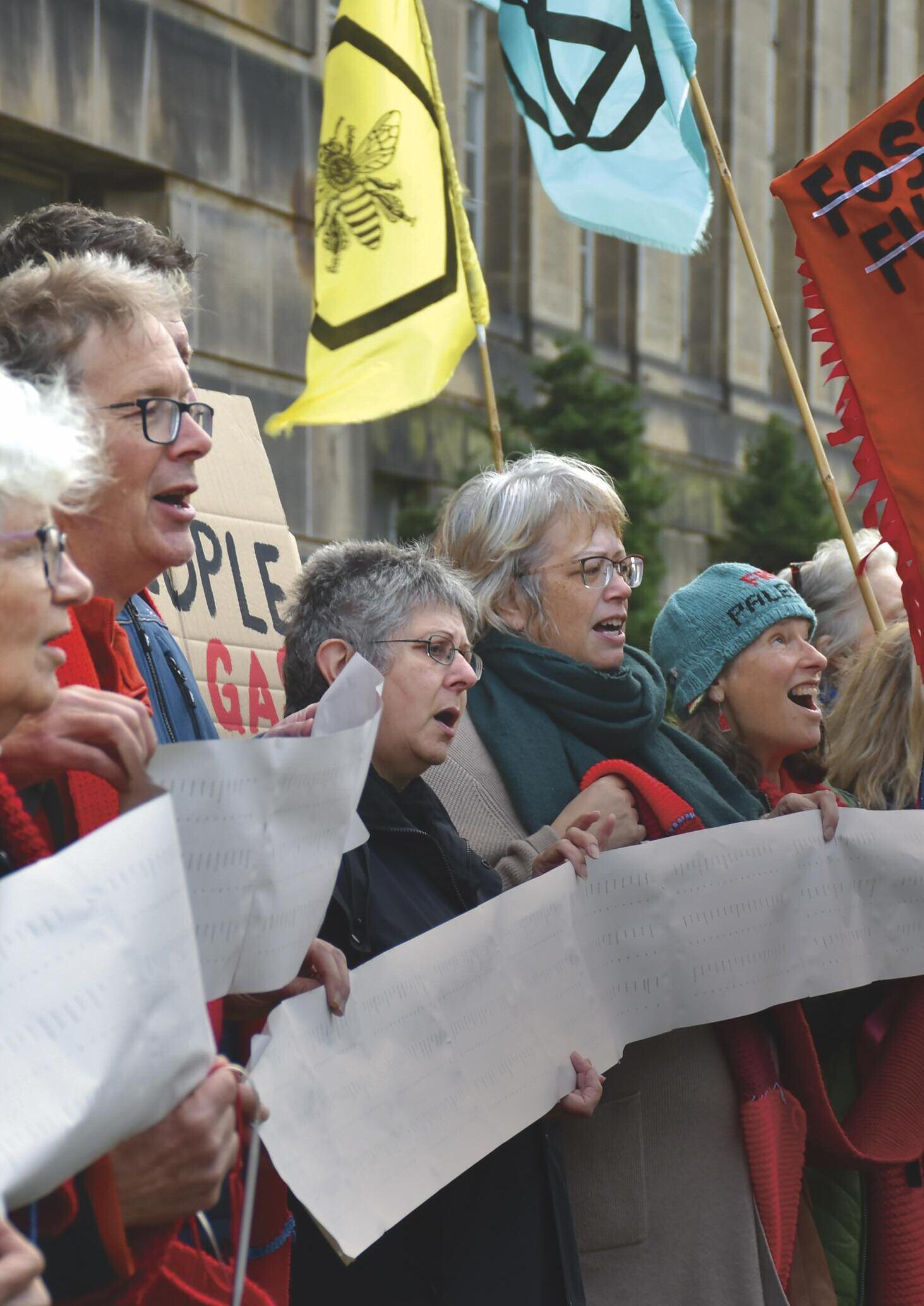

Friends of the Earth Scotland’s members’ magazine Issue 94 I Winter 2024

O N E A R T H
Friends of the Earth Scotland’s Members’ Magazine Issue 94 I Winter 2024
Friends of the Earth Scotland is:
> Scotland’s leading environmental campaigning organisation
> An independent Scottish charity with a network of thousands of supporters and active local groups across Scotland
> Part of the largest grassroots environmental network in the world, uniting over 2 million supporters, 73 national member groups and 5,000 local activist groups
Our vision is of a world where everyone can enjoy a healthy environment and a fair share of the earth’s resources.
Friends of the Earth Scotland is an independent Scottish charity SC003442
What on Earth is published by and copyright to: Friends of the Earth Scotland, 5 Rose Street, Edinburgh EH2 2PR
T: 0131 243 2700
E: info@foe.scot
W: www.foe.scot
Editor: Eilidh Stanners
Design: Emma Quinn
Cover photo: Ric Lander
The views expressed in What on Earth are not necessarily those of Friends of the Earth Scotland FoES accepts no liability for errors, omissions or incorrect data in advertisements
If you would prefer to receive a digital version of What on Earth please contact us: info@foe.scot
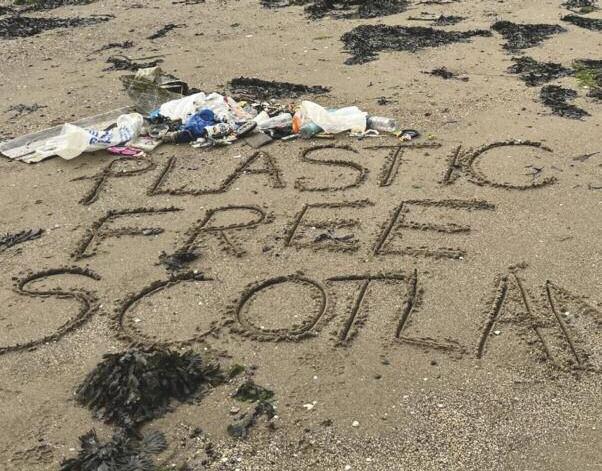

By Rochana Sheward, Director

As I write this, I’ve been in my role as Director for just under two months. I am continually impressed by the team’s commitment, passion, and deep understanding, especially following a year led by an interim Director. Thanks to their efforts, the organisation is in a strong position to drive forward in our fight for climate justice.
With this solid foundation, I am optimistic that we can make substantial strides toward our goal to phase out fossil fuels this decade. Returning from New Zealand to the country where I spent my first 22 years, it’s disappointing to see the Scottish Government, like so many others, deflect blame rather than pursue real climate solutions for people and the planet.
Still, there’s plenty to celebrate. Wins, both big and small, keep hope alive. I firmly believe that without them, our planet’s future would look much bleaker. In recent months we’ve improved the new Circular Economy law, stood alongside trade unions to support workers and protested against big polluters. I’m confident that the power of collective action will drive the change we urgently need.
In the months ahead, my priorities are to assess how our new strategy has taken shape, identify areas that still need focus and develop ways to measure our impact effectively. I’ll be working on a practical plan to hold politicians accountable, ensuring they can’t bury their heads in the sand while we prepare to take on challenges posed by the companies trashing our environment.
I’m eager to connect with more of our members, supporters, and collaborators, building strong relationships to fuel our mission.
Thank you for being part of this journey.
Rochana



























































EH15 1AF



Sat 22 Feb 2025 7pm























Portobello Town Hall



Join us for an unforgettable evening of music, dance, and mouthwatering local food at our ceilidh!
Hosted by the Ceilidh Collective, this celebration supports Friends of the Earth Scotland and Porty Community Energy, uniting local climate action with national efforts.
In these challenging times, joy and love are essential drivers of change. Don’t miss this opportunity to connect with fellow supporters and celebrate our shared commitment to the planet. We can’t wait to dance with you!
Get your tickets at ceilidhcollective.org. Prices range from £10 to £25, based on what you can afford.
Alex Lee, Climate Campaigner
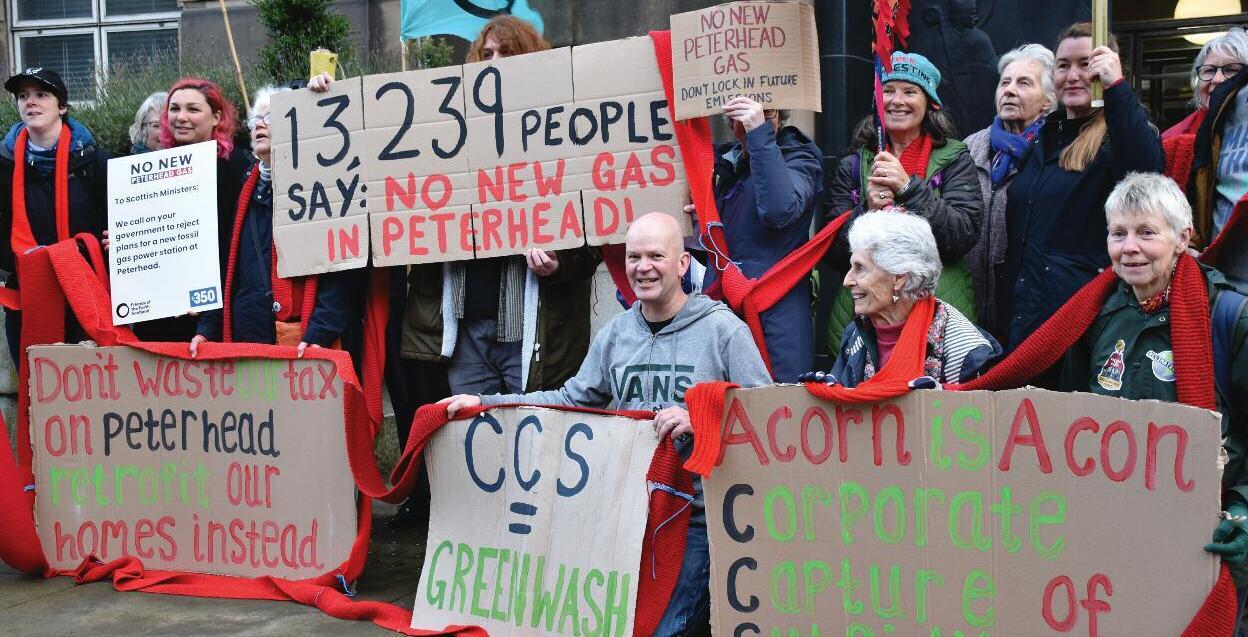

New research has revealed that the proposed Peterhead power station is even worse for the climate than originally feared.
We commissioned an independent analysis by experts at Carbon Tracker which found the climate pollution each year could be 5 times worse than the developers SSE and Equinor have admitted in official documents.
The research exposed huge holes in the companies’ analysis, meaning that the project could be responsible for 1 million tonnes more climate emissions every year than they previously claimed.
This means that the Scottish Government, who will decide whether to approve or reject the planning application for the power station, risks acting without the full evidence of the damaging climate impact it will have.
As a result of these revelations, we are demanding that the Scottish Government orders these companies to do an honest assessment of its climate harm. The UK Government recently ordered a similar carbon capture project, Net Zero Teesside, to redo its climate calculations.
SSE’s Environmental Impact Assessment, a legal requirement in planning applications, contained three huge holes. The companies failed to account for:
> Pollution created by extraction and transportation of the gas to be burnt onsite
> Pollution from the inevitable times when the carbon capture plant is turned off or undergoing maintenance
> Realistic estimates of how much carbon the technology would capture
SSE and Equinor claimed that the plant would capture 90–95% of the carbon dioxide it produces but this has never been achieved anywhere in the world and is not supported by evidence.
The only pilot projects trialing carbon capture on a gas power station were found to be just 1/20th of the size of the proposed Peterhead plant Researchers instead modelled the emissions produced at a more conservative 75% carbon capture rate, revealing a far higher climate impact from the project
When the carbon capture plant is not working – either due to planned maintenance or as a result of some of the failures that plague this technology – pollution will be ten times higher.
SSE knows that the Peterhead station will burn gas to generate electricity, yet it failed to include the emissions that are produced by the extraction, processing, and transportation of gas to the power station


As gas from the North Sea runs out the UK Government forecasts that this will increase imports of Liquified Natural Gas (LNG) – predominantly from USA or Qatar – which has a far higher carbon footprint.
LNG is produced by fracking in the USA –a process the Scottish Government has rightly banned in Scotland The process of cleaning and liquefying natural gas so that it can be shipped is incredibly energy intensive.
The plant is scheduled to continue burning fossil fuels until 2059, yet the company’s assessment fails to include the predicted changes in the carbon footprint of its fuel throughout the project lifespan.


The increased emissions from the plant would have what the research describes as a “major adverse impact” on Scotland's carbon budget As we get closer to net zero, the total amount of carbon that can be emitted progressively reduces
This means Peterhead power station could consume the equivalent of 50–80% of Scotland’s total annual budget by 2044. This would force other sectors of the economy including farming, transport and other businesses to reduce their emissions much more rapidly.
SSE and Equinor have deliberately hidden the true climate impact of their proposals It looks like Scottish Government ministers
have been misled through selective carbon accounting and wildly unrealistic forecasts.
This research shows how greedy energy companies are making claims about carbon capture that do not stand up to the slightest scrutiny. These companies are willing to say whatever it takes to get this project built, leaving the Scottish public to bear the cost of its inevitable failure for the next 30 years
The risk to the public is very real On top of the climate cost, locking our energy system into expensive and volatile fossil fuels for the next 35 years means that household bills will be driven by international energy markets far beyond our control.
When the Scottish Government sees the true harm of this project, the only rational response will be to reject it and focus instead on rapidly building up Scotland’s renewable energy future.
Kim Pratt, Circular Economy Campaigner


We all know by now that plastic is harming the environment. Making it causes climate wrecking emissions, it clogs up our seas and rivers, it lasts for hundreds of years, and it harms our health along the way. Despite this, we are making more and more of it. Globally, almost 12 million tonnes of plastic packaging are produced every year. In Scotland alone, we are producing 2 million plastic bottles every single day.
To stop the endless expansion of plastic production, global cooperation is needed. We hope that this is in sight, and that we might see the plastics crisis finally being tackled.
In 2022, the UN set a goal to develop a Global Plastic Treaty by 2025 to end plastic pollution.
Since then, countries from around the world have met regularly to negotiate the terms of the treaty The final meeting is taking place in Busan, Republic of Korea from 25 November to 1 December this year The world’s first ever global plastics pollution treaty is a unique opportunity to change the way this harmful material is used for good
While this has the potential to be a hugely positive step, like with the annual COP meetings on climate change, there is a risk that plastic producing countries and corporate lobbyists will weaken the final agreement. In this article, I’ll look at what must be included to make the Global Plastics Treaty a success, and the current situation with negotiations at the time of writing
Previous measures to tackle the plastic crisis have proven insufficient. In 2018, the Scottish and UK Governments, along with many other governments and hundreds more organisations signed the New Plastics Economy Global Commitment. This voluntary initiative has failed to make progress, and the 2025 targets are expected to be widely missed.
This approach failed because it did not address the root cause of the plastics crisis –the continual growth of production. Now, it is imperative that the Global Plastics Treaty does not repeat this mistake
To be effective, the Global Plastics Treaty must contain several key components:
> It must be legally binding, rather than voluntary, to make sure all parties take action on their promises,
> The treaty must encompass all plastics and every stage of their use, from production to waste, so that all the impacts of plastic pollution are addressed,
> It must promote reuse to reduce the demand for plastic, rather than false solutions such as chemical recycling (a risky, expensive and inefficient way of breaking plastics down into oil to be used again which has been labelled as a ‘dangerous deception’ by campaign groups) and plastic offsetting (polluters paying for the damage of their plastic production rather than reducing the amount they make),
> Hazardous chemicals found in plastics must be fully identified and eliminated,
> Financial mechanisms and new investments from rich countries to lower income countries are needed to support a just transition to a fairer future for everyone.

Above all, the Global Plastics Treaty must have a goal to reduce plastic production at its heart. Only policy makers can hold producers and retailers to account for the harm created through their plastic products, and this agreement should make them do so.
Many countries are prepared to create a treaty which meets these high ambitions. The UK, along with 65 other countries, is part of the High Ambition Coalition. Their shared goal is to end plastic pollution by 2040 In September 2024, the group reaffirmed

its ambition to “protect human health and the environment from the severe effects of plastic pollution”.
Countries in the Global South are feeling the impacts of the plastics crisis more than others and they are at the heart of proposing the most amibtious solutions. Peru and Rwanda have suggested a target to reduce plastic production by 40% by 2040 Over 50 countries have signed the ‘Bridge to Busan’ declaration pressing for more ambitious action. The UK Government recently signed this declaration, but the Scottish Government has not yet publicly supported it.
Other parties, especially those countries with high levels of fossil fuel and plastic production, are seeking to water down the treaty. Russia, Saudia Arabia and India have opposed targets to limit plastic production, preferring to focus on promoting recycling Recycling cannot solve the plastic crisis alone because it doesn’t tackle the massive demand and production of new plastic products There are also splits over the level of detail the treaty should include, how legally binding it should be and what the financial mechanisms should look like.
Powerful corporate giants, including Coca-Cola, PepsiCo, Unilever and Nestle, have been allowed to closely participate in the negotiations and are accused of using delaying tactics and promoting false solutions. Greenwashing tactics are rife
Despite this opposition, momentum for a more ambitious treaty is building. In May, Japan joined the High Ambition Coalition, leaving the USA as the only member of the G7 not part of the group. As one of the world’s biggest plastics producers, the USA has sat on the fence for two years of negotiations. In August 2024, the US Government signaled for the first time that it will push for measures to limit production
This excited environmental groups who called this move the “turning of the tide towards a more ambitious treaty”.


However, it is unlikely that incoming president Donald Trump will ratify a treaty which does anything but put American businesses first, which will be a significant challenge for the High Ambition Coalition negotiators
As we reach the end game of negotiations, the world holds its breath. Can negotiators pull off the rarest of things – an international environmental treaty that is ambitious and strong enough to meet the crisis it aims to end?
Sally Clark, Divestment Campaigner

UK pension funds are investing a staggering £88 billion in fossil fuel companies that are fuelling the climate emergency. That works out at around £3,000 per pension fund member invested in some of the world’s biggest polluters.
While oil and gas companies like BP, Equinor and Shell often make impressive-sounding promises to be ‘net zero by 2050’, the reality is that these corporations are continuing to expand the extraction and burning of fossil fuels whilst making huge profits, lobbying against meaningful climate action and abandoning their renewable energy projects.
Our workplace pension funds are supposed to help us save for our retirement. By investing in fossil fuel companies that are driving up climate emissions at a time when people and wildlife across the globe are already suffering from record temperatures and extreme weather, UK pensions are funding climate chaos.
The good news is that it doesn’t have to be this way Our pensions have the potential to help power a just transition to real climate solutions that can benefit communities here in Scotland and around the world
Friends of the Earth Scotland is joining our UK Divest partners at Platform London to launch a new Fossil-Free Pensions campaign which will call on workplace pension funds to remove our savings from climate-wrecking fossil fuels.
We’re starting with one of the UK’s biggest pension funds, Nest (the National Employment Savings Trust) Nest is a workplace pension scheme that was set up by the Government in 2010. It’s open to self-employed workers and to any employers who can auto-enrol their staff members into the scheme.
As a public body, Nest does not have any owners or shareholders, and it’s meant to be run in the interests of its members However, Nest’s default pension fund, the
Retirement Date Fund, currently invests its members’ wages in some of the world’s worst climate polluters. This includes BP, Shell, TotalEnergies and the Norwegian oil giant, Equinor.
This campaign will put pressure on Nest to divest their default fund from fossil fuels. We’ll do this by mobilising Nest members to switch their pension to Nest’s ethical fund, which does not invest in fossil fuels. By moving to the ethical fund, Nest members not only remove their money from big polluters like BP and Shell, but they also send a strong message to Nest that we want them to invest our wages to protect people and the planet, not the dirty profits of oil and gas companies.
We’ll work together with workers, employers and unions to collectively show Nest that we want our workplace pensions to be fossil-free.


“
Divestment simply means no removing investment from unethical companies. Nest’s default pension fund currently invests in big polluters, weapons manufacturers, and other harmful companies
Fossil fuel companies are some of the wealthiest and most powerful companies on the planet, and they’re using their money, power and influence to block every serious attempt to stop climate change.
By divesting – and, importantly, getting institutions like Nest to publicly break ties with fossil fuel companies – we can weaken the influence of the fossil fuel industry and block the money pipeline to oil and gas companies that are driving the climate crisis.
Every time an institution publicly breaks its ties with fossil fuel companies, we chip away at polluters’ power to carry out their toxic activities and damaging business plans
So far, over 1,630 institutions have already pledged to divest around $40.76 trillion from planet-wrecking fossil fuel companies These include some of the world’s biggest pensions such as New York City’s pension funds and the €237.8bn PFZW fund for healthcare and welfare workers in the Netherlands which divested €2.8bn from 310 fossil fuel companies earlier this year.
With your help, we can call on Nest and other UK pension funds to join them
Nest is the largest workplace pension provider in the UK, currently serving nearly 40% of workers (and counting!) That’s over 1 million businesses and over 12 million workers, with almost £43 billion held by Nest.
When new members join Nest, they are automatically enrolled into the Retirement Date Fund which invests in major fossil fuel companies like BP, Shell, Equinor and TotalEnergies – that’s billions of workers’ hard-earned wages being funnelled into polluters that make our working lives harder and puts our future retirement at risk.
With 99% of Nest members currently in the default fund, it’s time for us to switch to the ethical fund together and divest our salaries from fossil fuels.
If you have a workplace pension with Nest, you can switch to the fossil-free Ethical Fund in a few easy steps This will move your own savings away from oil and gas companies that are driving climate breakdown and add to the growing number of Nest members who are calling on the fund to be fossil-free.


Freya Aitchison, Oil and Gas Activism Officer


As you know, SSE and Equinor, two massive fossil fuel companies, want to build a new power station in Peterhead. They want to do this so that they can continue profiting from burning gas for electricity for years to come. If the Scottish Government gives them planning permission, this development would prolong our reliance on gas as well as locking us into continued high bills that are tied to the volatile international price of gas.
The project is built on the rotten foundations of carbon capture and storage in an attempt to it give it climate legitimacy, but all the evidence shows that this technology will not work at the scale it has been promised, and the plant will still be a huge polluter (you can read more about the scale of this on pages 5–7).
The good news is that the climate movement in Scotland has been fighting this project at every turn, and is starting to make real progress in exposing the dodgy decision making around this development.
Here are some of the many things that people have been doing to stop the new power station for good:
Activists all around Scotland have been running stalls, talking to their neighbours, and handing out flyers letting people know about the controversial power station development From choir practices to freshers’ fairs, we’ve had hundreds of conversations with people about the power station and gathered signatures for our petition Running a street stall is a great way to get involved in campaigning against new fossil fuels wherever you live
Activists also took the fight directly to the developers’ doorsteps on several occasions. On the day of Equinor’s AGM back in May, we gathered at their Aberdeen offices to send them the message that ‘Scotland will be fossil free’ – with or without them. The North Sea Knitters also staged a knit-in at SSE’s offices in Perth, where they spoke with SSE bosses at length about why they think the new power station is a bad idea Showing up with a physical presence at their offices shows these companies that we are not going to back down
In July, SSE held its AGM in Perth. A large group of activists held a protest outside the venue, with chanting, banners, and a massive model power station – people going into the AGM couldn’t miss us! Several activists also disrupted the AGM from the inside, interrupting the board’s address and reminding them that if they really cared about Net Zero as they claim to, they would stop building new fossil fuel infrastructure
In September, the North Sea Knitters held another knit-in at the Scottish Parliament and invited their MSPs to come and meet them t o receive a red hand-knitted scarf and talk about stopping fossil fuels First Minister John Swinney came out to meet one of his constituents and was grilled on why he has so far refused to reject the plans for Peterhead




Activists gathered outside St Andrew’s House to hand in a petition to the Scottish Government urging them to reject the plans for the new power station. Over 13,000 people signed the petition so this was an important milestone and a clear sign to the Scottish Government that there is widespread opposition to new fossil fuels at Peterhead.
There’s still a long way to go to convince the Scottish Government that new gas infrastructure is not the answer to the climate crisis, but these actions have definitely put the Peterhead power station on the map
It is dedicated people like you who provide the people power to make the changes we so desperately need – so a huge thank you to each and every one of you who has been involved in any of these actions or the many others that have taken place as part of this campaign.
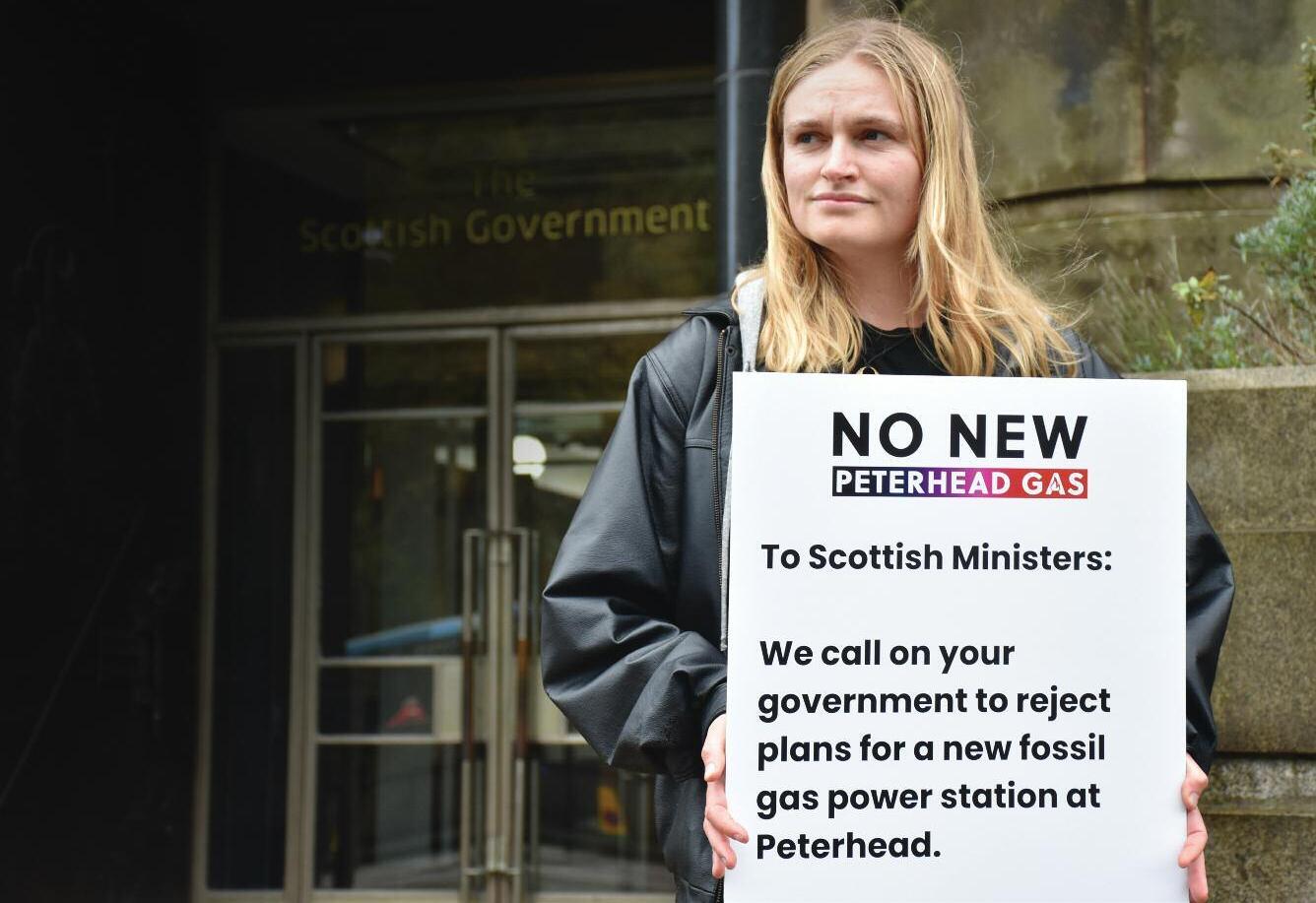

Connal Hughes, Communications Manager
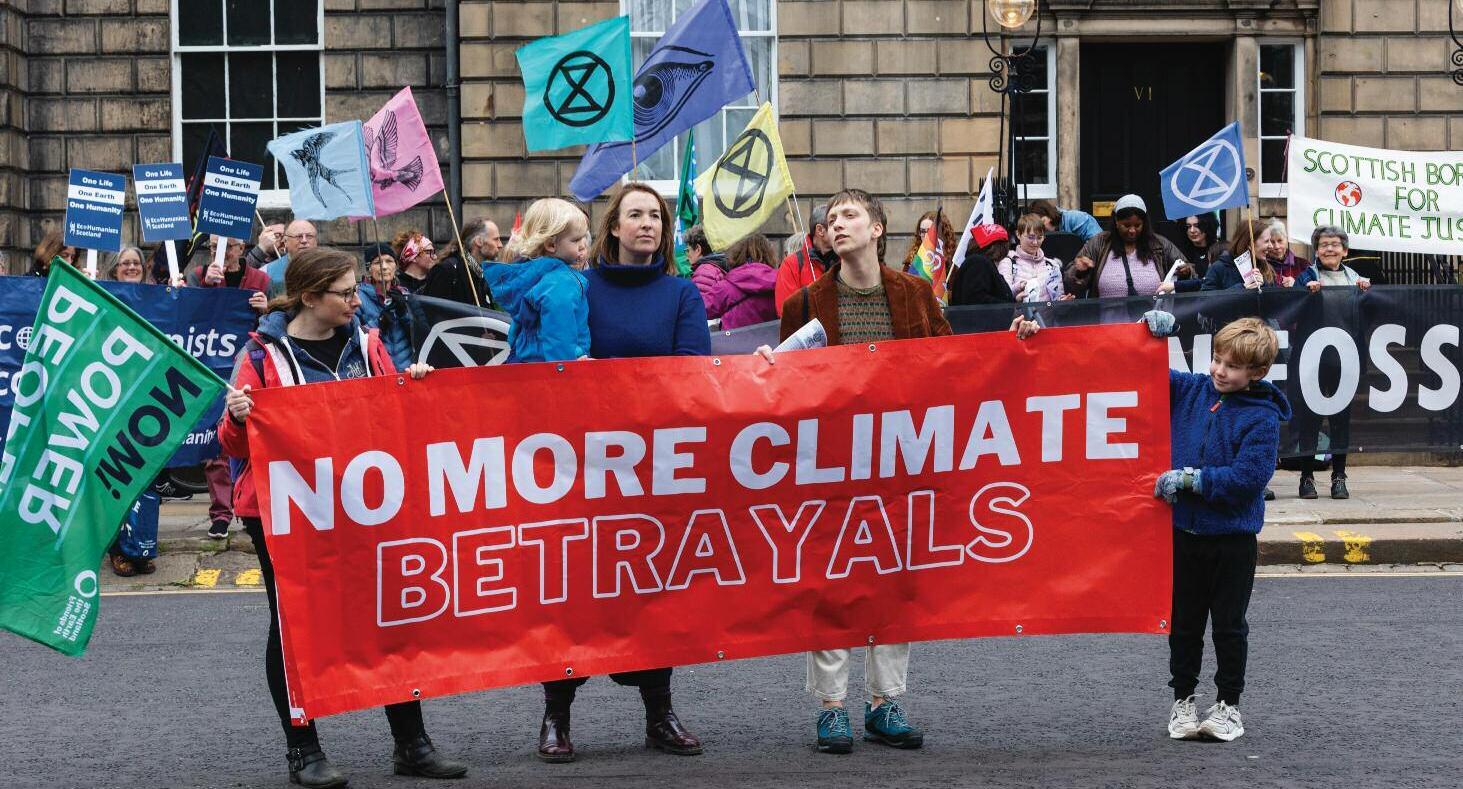
People turned out outside Bute House to protest the decision to scrap climate targets when it was announced. Images: Iain McLean
The Scottish Government has scrapped its climate targets. This is a truly abysmal decision, that is the result of it failing to take the action needed to achieve them. These targets were based on what Scotland needs to do as part of global efforts to urgently reduce climate pollution.
The Scottish Government announced its plan to do this in April, and MSPs passed the legislation on 5 November
Scotland’s climate targets were a legal commitment to action The Scottish Government had to measure its progress each year in reducing climate emissions and make a public statement as to whether the goal had been achieved and why Scotland set strong targets because of public pressure for climate action during 2019.
The Scottish Government praised itself as a climate leader. Nicola Sturgeon took a prominent role at the COP26 climate conference in Glasgow, was pictured alongside Greta Thunberg and the Scottish Government joined international groupings taking up action
We now know that was a facade. The reality was that ministers were not willing to do the hard work of bringing in the changes needed that would improve lives and bring down climate pollution.
In fact, the Scottish Government has missed 9 out of 13 annual targets since Scotland’s first Climate Act was introduced in 2009 Targets should be challenging – that’s what should drive forward action But that level of failure is unacceptable.
Ministers repeatedly refused to create credible climate plans which would spell out how and where emissions would be cut. Instead they delayed and dodged decisions – refusing to stand up to big polluters or seriously improve public transport
The environmental movement reacted furiously calling it a ‘betrayal’, ‘a global embarrassment’ and we called it ‘the worst environmental decision in the history of the Parliament’.
Young people going on climate strike from school hit the headlines around the world – including huge protests in Edinburgh and Glasgow just before the climate target vote in September of that year. All of these people have been let down by the Scottish Government’s failure to live up to its promises


The Scottish Government will move to a five-year carbon budget approach instead. Carbon budgets are when the total emissions for a five year period are calculated and staying within this total becomes the goal. The main issue with this approach is that the targets are far weaker So effectively instead of the old targets aiming to cut pollution by 75% by 2030, now the goal will likely be to cut pollution by 68% by 2030
Another downside of this is that multi-year budgets are a bit harder to track progress year on year – even though ministers say they will update parliament each year
When the Scottish Government announced it would scrap 2030 targets, it also produced a package of what it called “catch up measures”. This package was roundly panned as being woefully insufficient to the challenge of getting climate action back on track.
Now that the removal of climate targets has been finalised, it must commit to taking effective action Here are just a few ideas that Scottish Government could implement:
> Remove peak train fares permanently and support local authorities to run bus services in the public interest
> Deliver a credible just transition plan that involves workers and communities in delivering a rapid shift away from fossil fuels.
> Ramp up the roll out of insulation schemes to ensure every home is well insulated and energy bills are reduced
> Reject the climate polluting plans to build another gas burning power station at Peterhead.
> End its desperate over-reliance on carbon capture technology which has repeatedly failed despite swallowing up huge amounts of public money.
We will keep on demanding the transformative ideas that will improve people’s lives as we cut climate-changing pollution.
Kim Pratt, Circular Economy Campaigner
New research has shown that we are burning more and more rubbish in Scotland. The figures, which are published annually by SEPA, show a huge surge in waste burned from 2022 to 2023, a bigger rise than the previous three years combined.
The data also shows that Scottish household recycling rates have remained at a standstill, moving from 43.3% to 43.5% from 2022 to 2023. These figures have flatlined for a decade, despite a previous commitment from the Scottish Government to reach 60% by 2020
Incinerators create dirty emissions which pollute the air locally and contribute to climate breakdown. Incineration is a problem across the UK – a new BBC investigation has found that burning rubbish is the dirtiest form of power generation

But in Scotland the problem is particularly severe We have the worst recycling rates in the UK, and we can’t increase recycling if we are burning more and more of our waste in incinerators
The Scottish Government introduced a ban on new incinerators in 2022 but failed to close important loopholes which means it is not effective Since the ban, incinerators have been switched on in Aberdeen and Grangemouth and construction has begun in Fife, Irvine, Glenfarg and South Clyde. In June this year, Aberdeenshire Council supported a developer to maintain their planning permission for the Inverurie incinerator, bypassing the ban, despite the Aberdeen incinerator being only 17 miles away.


The ban does not cover changes to capacity at existing incinerators, creating another loophole. Scotland’s largest incinerator, Viridor’s Energy Recovery Facility in Dunbar was awarded a permitted capacity increase of 20% from SEPA in July 2023, a year after the moratorium was introduced.
The Scottish Government does have the power to close these loopholes Incinerators need permits if they are going to begin operations, which are given by SEPA The Scottish Government can direct SEPA to refuse to give any further incinerator permits to stop new ones from operating The Scottish Government has acknowledged that they have such powers but are refusing to use them except in “exceptional circumstances”. The regulations do not require exceptional circumstances, but the current situation, where only urgent action can prevent decades of incineration overcapacity, is exceptional.
When the Scottish Government introduced the mortarium on incinerators, it stated that this was done to limit capacity. However, incineration capacity has increased by 215,000 tonnes already Before 2018, Scotland had just two incinerators. Ten years later, in 2028 Scotland could have 17 incinerators, if all plants with planning permission are built. If it doesn’t take action to close the loopholes and stop more waste from being burnt, its ban will be meaningless.
If ministers fail to act, Scotland will have more incinerators than there is waste to burn by 2028 This could mean ending up in the perverse situation of operators seeking more waste to burn, including importing it from outside Scotland. Incinerators take three years to build so the Scottish Government must act now to prevent this becoming a reality
You can help by asking your MSPs to push the Scottish Government to close the loopholes. We’ve drafted an email for you to send at act.foe.scot/loopholes



